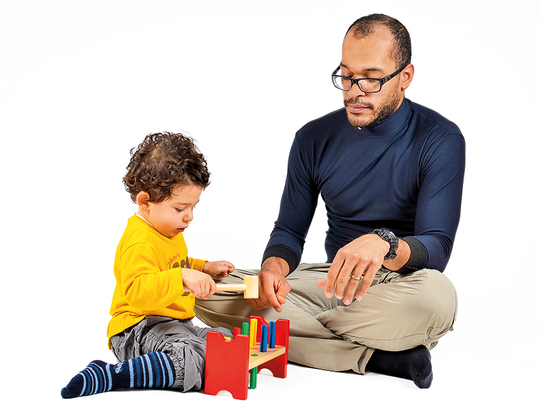
Autism experts all over the world are still unclear about a lot of things concerning the developmental disorder. However, the one idea that most of them have come to accept is that the earlier the condition is diagnosed and the sooner interventions — from medication to behavioural therapies — can be tried, it’s more likely that the child will develop into a productive individual.
No one seems to know what causes autism spectrum disorder (ASD), but there are many theories and links, ranging from environmental, biological and genetic factors to maternal age at the time of conception. “ASD is like any other disorder where the causes are not yet known,” says Sara Baker, Head of Community Service Unit at Dubai Autism Centre. “If we don’t know where exactly it’s coming from, it is difficult to avoid it.”
The problem is, while we wait for researchers to come up with a solution, more and more children are being negatively impacted by the condition. You can’t prevent having a child with an autistic disorder, but if you recognise those early red flags you can change the child’s behaviour and shift them towards a pattern of more normal development.
“We encourage parents to observe their child at an earlier stage,” says Baker. “When parents interact with their child they should look for any developmental delays. They should have more conversations and not leave the child with any electronic items for a long period of time. These small measures can be very helpful in decreasing any symptoms that have developed in any child.”
Signs and symptoms
ASD appears in infancy and early childhood, causing delays in many basic areas of development, such as learning to talk, play and interact with others. Parents are in the best position to spot the earliest warning signs of autism as they know their child better than anyone and observe behaviours and quirks.
“At an early stage we must always look at the social interaction of the child — the eye contact, the smiles, if the baby raises its arms to be carried, or when the parents leave the room the child is upset or not,” says Baker. “All this is a part of the child’s social interaction, wanting to play, wanting to share a toy, when playing he/she would look at the parent or sibling and want them to look back at them and smile.”
As children get slightly older, the red flags for autism become more diverse, so parents must observe their child’s growth closely in the first three years.
“The first two years are crucial. The parents and the family need to be very aware,” explains Baker. “We will have to look at three different factors — the behaviour, the speech and the social interaction. If there’s only delay in walking and they are socially active, then you don’t have to worry as that will come further down the line. Even with speech, if there’s still no developed language or if the child speaks less than normal for kids that age, but all the other communicative development is fine then we don’t have to worry. And that’s why we do the diagnosis at the age of two years as we wait for speech to develop. Also look for regression of any type. For instance, if they’ve picked up something initially and then regressed we have to take that into consideration.”
Reducing anxiety can help
A recent study by the Autism Research Collaboration at Erasmus MC-Sophia Children’s Hospital and Yulius Mental Health in the Netherlands found that anxiety can actually worsen autism. Is this true?
“It is true to some extent,” agrees Baker. “Imagine yourself walking into a mall and you are sensitive to everything around you such as the lights, the different colours, the smells, the noise, the people, and so on. All this information comes through your brain at the same time and you will become very anxious.”
This is the reason, according to Baker, individuals with ASD have repetitive behaviours, whether it’s rocking, hand-flapping, tapping their fingers, or just repeating words and sentences. “If they’re allowed to continue what they are doing it lowers their anxiety. That’s why we are conscious with every individual as to what increases their anxiety level and we try to avoid it. We teach parents and others concerned what to do when and if it happens.”
While you may never be able to get rid of everything that causes anxiety or stress for your autistic child, there are some things you can do to help ease your child’s worries and encourage them to manage their own anxiety levels.
“Don’t stop their behaviour. If they have a repetitive behaviour, for instance, they rock in public don’t stop that. What you have to do is give them an option.
“Now say if the individual concerned is a young man of 18 years of age. When it’s done in public, people around may not understand and wonder why he’s doing that. We give this individual another option to reduce the stress, whether it is a stress ball, an iPad or a smartphone. At that point they know what to look for and may play a game that will take their mind away from the anxiety.”
Also, the signs and symptoms of ASD vary widely, as do its effects. Some children with autism have only mild impairments, while others have more obstacles to overcome.
Anxiety can be stopped by adopting a behaviour plan to understand what triggers it, how to treat it while it’s happening, and how to put an end
to it.
“The thing with autism is that it’s difficult to treat because it’s unique. It is not the same for every person as they have different behaviours.”
Impact on friends and family
From the moment they begin to suspect that their child isn’t developing in a neuro-typical way, families of children with ASD begin to face challenges that set them apart from other family groups.
“The most important thing is the acceptance of society,” says Baker. “Everyone needs to be aware of this condition. Parents don’t need help because they know exactly how to deal with their child, but they need support and understanding from people around so that they feel comfortable going out anywhere in society.”
While accepting that the understanding of the condition has evolved in recent years, Baker says, “We started more than 10 years back when there was social shyness — families wouldn’t venture out as they feel embarrassed to have a child behaving that way. Now it’s much better.”
Autistic people find interacting with others difficult, so dealing with an autistic person can be enormously challenging, demanding tolerance, kindness and patience. They also tend to be withdrawn, preferring to spend their time on their own.
“When you come across an autistic person, or if you see something happening between a mother and kid do not interfere in anything,” advises Baker. “These individuals will always have a shadow, either a parent or a sibling, who knows how to deal with them. Do not go to help unless they ask for help. If they need help they will ask the person who’s with them.”











